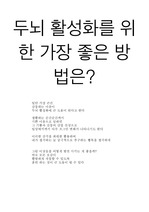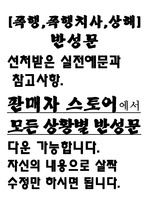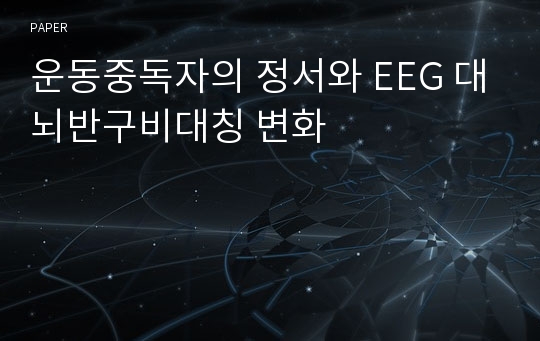* 본 문서는 배포용으로 복사 및 편집이 불가합니다.
서지정보
ㆍ발행기관 : 한국웰니스학회
ㆍ수록지정보 : 한국웰니스학회지 / 9권 / 3호
ㆍ저자명 : 김성운, 하태호
ㆍ저자명 : 김성운, 하태호
목차
Ⅰ. 서 론Ⅱ. 연구방법
Ⅲ. 연구결과
Ⅳ. 논 의
Ⅵ. 결 론
참고문헌
한국어 초록
본 연구의 목적은 운동중독자를 대상으로 운동중의 감정변화뿐만 아니라 운동전과 운동 후의 정서변화 추이를 측정하여 일반운동자와 비교 분석하는 것이다. 그리고 운동중독을 뇌 생리심리적 접근인 EEG 대뇌반구비대칭 활성화지표를 활용하여 운동중독자의 정서적 변화의 메커니즘을 검증하는데 있다. 본 실험에 참여한 피험자들은 K대학교의 마라톤 동아리에서 활동하고 있는 남자 대학생 70명 중에서 운동중독자로 판명되는 12명을 선정하였고, 일반운동자 12명은 운동중독자와 유사한 연령대로 평소에 일정시간 이상 신체활동을 실천하는 건강상태가 양호한 남자대학생이었다. 측정 시점별로 감정의 변화를 알아보기 위하여 2차원 원형모형 그래프를 작성하여 해석하였고, 운동중독자와 일반운동자의 시점별 감정 변화 양상과 긍정적 정서, 부정적 정서의 운동전후 그리고 EEG 대뇌반구 비대칭 차이지표를 비교하기 위하여 반복측정에 의한 2way-ANOVA를 실시했으며, 사후검증을 실시했다.본 연구결과 운동중독자의 경우 운동 중에 감정이 긍정적으로 바뀐다는 점과 일반운동자는 운동 중에 심각할 정도의 불쾌감을 체험한다는 것으로 확인하였다. 이러한 사실들은 운동 동기유발을 위해 운동 강도와 함께 운동 중의 감정변화도 중요하게 점검할필요가 있다는 것을 보여주는 것이라고 생각된다. 또한 본 연구는 기존의 운동중독연구에서 실시한 자기보고서 방식과 질적 연구방식에서 벗어나 뇌 생리적 접근을 통해 좀 더 객관적이고 과학적으로 운동중독에 대한 정서적 메커니즘을 제시했다고 사료된다.영어 초록
This study examined the neurophysiological mechanisms of exercise addiction by determining differences in self-reportedchanges in emotions and EEG frontal asymmetry in relation with exercise. Twenty-four male undergraduate university students,ages ranges from 20-27years, amateur marathon runners were selected and an equal number of participants (n=12) were assignedinto one of two experimental conditions; 1) exercise addiction group (n=12), and 2) non-exercise addition group (n=12). FeelingScale and Felt Arousal Scale were administered to assess self-reported emotions at pre, during (5, 10, 15, 20, 25, 30 min), andpost-exercise times (10, 20, 30 min) in relation with 30 min moderate to high intensity running on treadmill. Moreover, PANAS-Xand recording of EEG from F3 and F4 scalp sites were performed at pre, immediately after termination of exercise, and 30 minpost-exercise times. Results revealed that participants of EAG significantly improved positive emotions during exercise on EEGand self-reported measures, and showed maintenance in positive emotions during the rest period after the end of exercise onself-reported measures. In contrast, participants of NEAG experienced negative feelings during exercise period but showedremarkable recovery in emotions during 30 min post-exercise resting period according to both self-reported and EEG measures.Findings suggest that exercise addiction possibly linked with exaggerated enhanced pleasant emotions during exercise. In contrast,increasing unpleasant emotions during exercise and decreasing unpleasant emotions during the recovery period after the end ofexercise indicative of healthy exercise behavior. The findings of this study suggest that EEG frontal brain asymmetry can beused as diagnosing method for the condition of exercise addiction.참고 자료
없음"한국웰니스학회지"의 다른 논문
 체력관리 수업이 남자 대학생의 비만지표 및 건강관련 체력에 미치는 영향10페이지
체력관리 수업이 남자 대학생의 비만지표 및 건강관련 체력에 미치는 영향10페이지 유방암 생존자를 위한 복합운동프로그램이 에스트라디올, IGF-I 및 CA15-3에 미치는 효과11페이지
유방암 생존자를 위한 복합운동프로그램이 에스트라디올, IGF-I 및 CA15-3에 미치는 효과11페이지 성인 남녀의 성별 및 연령에 따른 자연치유요법의 인지 정도와 선호 요법에 관한 연구11페이지
성인 남녀의 성별 및 연령에 따른 자연치유요법의 인지 정도와 선호 요법에 관한 연구11페이지 등척성 코어근육 강화운동이 초보골퍼의 스윙에 미치는 영향10페이지
등척성 코어근육 강화운동이 초보골퍼의 스윙에 미치는 영향10페이지 15주간 골볼운동이 대학생들의 기분상태, 신체적 자기효능감 및 운동수행능력에 미치는 영향14페이지
15주간 골볼운동이 대학생들의 기분상태, 신체적 자기효능감 및 운동수행능력에 미치는 영향14페이지 웃음치료가 우울증 여성 노인의 우울, 노인 삶의 질, 생리적 변화에 미치는 영향12페이지
웃음치료가 우울증 여성 노인의 우울, 노인 삶의 질, 생리적 변화에 미치는 영향12페이지 여대생의 신체활동 수준에 따른 우울수준과 대인관계성향의 관계10페이지
여대생의 신체활동 수준에 따른 우울수준과 대인관계성향의 관계10페이지 개방기술과제 시, 저 동기수준 학습자를 위한 변형된 자기통제 피드백의 학습효과10페이지
개방기술과제 시, 저 동기수준 학습자를 위한 변형된 자기통제 피드백의 학습효과10페이지 ADHD 아동의 운동프로그램 적용이 뇌파와 심리적 요인에 미치는 영향: 사례연구15페이지
ADHD 아동의 운동프로그램 적용이 뇌파와 심리적 요인에 미치는 영향: 사례연구15페이지 프로야구팬의 행동의사와 팀 자긍심, 애착도의 관계11페이지
프로야구팬의 행동의사와 팀 자긍심, 애착도의 관계11페이지

























